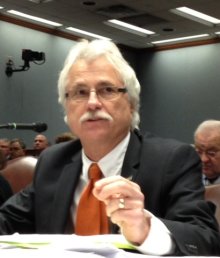
Public schools should be made safer without turning them into armed camps, Louisiana Federation of Teachers President Steve Monaghan told a legislative committee meeting in the aftermath of a horrific school shooting in Connecticut.
The union leader told members of the House Committee on Homeland Security that commonsense measures, including doors that lock and strong partnerships with law enforcement agencies, can be a big step toward ensuring the safety of students and the adults who work in schools.
Monaghan rejected the notion put forward by one lawmaker that teachers should be armed in order to face threats from outsiders like the man who burst into the Sandy Hook Elementary School, killing 20 children and six adults.
Citing his own experience as a Marine veteran, Monaghan said that the training available to most teachers would not be adequate to deal with a determined shooter.
“We have to be realistic about what the role of an educator is versus the role of a security enforcer,” Monaghan told the committee.
“I was an English teacher,” he said. “You don’t want me having a gun.”
Monaghan reported some of the preliminary results of an LFT survey in which teachers and school employees were asked to describe their school’s security measures.
The vast majority say that their school does have a crisis management plan as required by law, Monaghan said, but that some report deficiencies in the plans. Many reported that their classroom doors cannot be locked from the inside or without a key.
School officials have cited the cost of retrofitting schools with locking doors and safety features like “panic buttons,” an issue that Monaghan said needs to be addressed.
“We need to seek partnerships with appropriate state and federal agencies to fund the required modifications. If necessary, a request should be made to the congressional delegation asking for funds,” the survey report says.
Some teachers reported that their school board policies prohibit them from having cell phones on campus. Monaghan said that cell phones should be required, and that they should be pre-programmed with emergency telephone numbers.
A majority of respondents (61%) said that their school does not currently have armed security experts on campus, and an even greater majority (69%) said that armed security is needed on their campus.
“If a school decides to bring police into schools,” the LFT survey says, “they should be part of the fabric of the school community, not simply a stationed armed guard. School resource officers and programs like D.A.R.E. (Drug Abuse Resistance Education) provide rich learning experiences and opportunities for students in addition to being part of the school safety team.”
A majority reported that there have been violent incidents in their schools, but that most of those (62%) were initiated by students. Forty-three percent said that there have been incidents involving persons from off-campus. Most of those appear to have been parents or relatives of students in the school.
Most teachers (61%) said their schools handled the incidents appropriately, but a significant minority (39%) said the response was inadequate. Some said local administrators are afraid to report incidents or expel violent students because it would reflect poorly on the school’s performance scores.
The vast majority of violent incident in schools involve members of that school’s community, and steps should be taken to create welcoming and supportive school environments, the LFT survey recommends:
- Safe and respectful environments must be created for all students in our schools. Investing in ongoing schoolwide practices to reduce bullying behavior, increasing after-school activities, and integrating community services and programs like peer counseling, wellness programs and other social supports, are just a few examples of how communities like Baltimore and Cleveland have been able to reduce school-based violence.
- Programs encouraging partnerships between schools, local law enforcement and appropriate community agencies (such as mental health) must be created to prevent and reduce school violence. The program would establish the creation of school-based safety committees composed of parents, educators, student and administrators. Law enforcement and other agencies should develop ongoing relationships with school safety committees and work jointly with them to help create safe and respectful environments, prevent and address violent incidents in schools, and serve as a resource on all safety issues for the faculty, staff and student body.
To read the prelimihary report of the LFT survey on school safety and violence, please click here.
